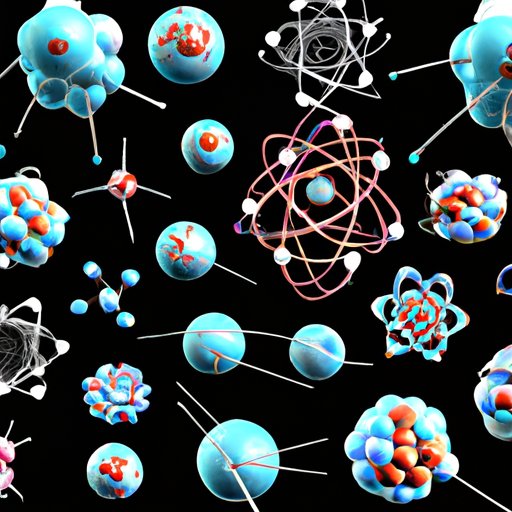How to Find Electrons: Exploring the Properties and Behaviors of Subatomic Particles
Electrons are among the tiniest and most fundamental building blocks of matter, playing a critical role in fields like physics, chemistry, and engineering. While they are not always visible to the naked eye, knowing how to find and observe electrons is essential for understanding their properties and behaviors. In this article, we will explore the basics of electrons, different models used to describe their behavior, and how modern technology enables us to observe their movements in real-time. We will also examine the role of electrons in electricity and chemical reactions and discuss the implications of ongoing research into their behavior for future technologies.
Understanding the Basics: What Are Electrons?
Electrons are subatomic particles with a negative charge that orbit the nucleus of atoms. They are incredibly small, with a mass that is approximately 1/1836th of a proton. They are responsible for the chemical and physical properties of atoms, such as their reactivity and bonding behaviour.
Scientists first discovered electrons in the late 19th century when they observed electrical currents and realized they were made up of moving particles. It wasn’t until the early 20th century that Danish physicist Niels Bohr first proposed the theory that electrons exist in specific energy levels around the nucleus. Since then, many models have been developed to describe the location and behavior of electrons within atoms.
Exploring Different Models: Bohr and Quantum Mechanical Models
One of the earliest models proposed to describe the behavior of electrons was the Bohr atomic model, which suggested that electrons travel in circular orbits around the nucleus of an atom. While this model was useful for explaining certain aspects of electron behavior, it was later found to be incomplete, and many of its predictions did not hold true.
Today, scientists use the quantum mechanical model to describe the behavior of electrons. This model suggests that electrons do not follow predictable paths around the nucleus, but instead exist within regions of space known as orbitals. These orbitals are not static but can change in response to external stimuli like temperature or electromagnetic fields.
The quantum mechanical model is more complex than the Bohr atomic model, but it provides a more accurate description of electron behavior. By using powerful mathematical equations, physicists can now predict the location and behavior of electrons with incredible precision.
Using Technology to Observe Electrons
Modern technology has enabled scientists to directly observe the behavior of electrons, providing valuable insights into their properties and the nature of matter at the atomic level. One of the most powerful tools for electron visualization is the scanning electron microscope (SEM). SEMs use beams of electrons to produce high-resolution, three-dimensional images of surfaces at the nanoscale level.
By observing electrons in real-time, scientists can better understand how electrons move and interact with one another. This information can be used to develop new technologies like superconductors or to enhance existing materials like batteries. It can also help us better understand chemical reactions and the creation of new materials.
The Connection Between Electrons and Electricity
The movement of electrons is a fundamental aspect of electricity, a phenomenon that has revolutionized human civilization. At a basic level, electricity involves the flow of electrons from one place to another. Electrons can either be static, as in a battery, or they can move through a conductor, such as a wire or circuit.
The manipulation of electron flow is essential for many electronic devices and technologies. For example, by controlling the movement of electrons, we can create transistors, which allow us to process information and perform calculations in computers. We can also create microchips, LED lights, and other high-tech devices.
The Role of Electrons in Chemical Reactions
Electrons also play a critical role in chemical reactions. In the process of chemical bonding, electrons are transferred or shared between atoms to form new compounds. The movement of electrons during bonding determines the chemical and physical properties of the resulting compounds.
By understanding the behavior of electrons during bonding, scientists can develop new materials with unique properties. For example, materials like high-strength polymers and corrosion-resistant alloys are created by manipulating electron behavior through careful chemical design.
Implications for Future Research
The study of electron behavior is a rapidly evolving field, with many exciting discoveries yet to be made. Continued research into the properties and behavior of electrons could lead to breakthroughs in areas like energy storage, computing, and materials science. By better understanding the behavior of electrons, we can create new technologies and materials that are more efficient, sustainable, and impactful.
Conclusion
Electrons are the unsung heroes of the subatomic world, playing a critical role in the properties and behavior of matter. By understanding how to find electrons and observe their movements, we can gain valuable insights into the nature of matter and the properties of the world around us. From the basics of electron behavior to the latest technologies for electron visualization, there is a wealth of knowledge to be gained by exploring the world of electrons.
For those interested in learning more, there are countless resources available online, including scientific journals, textbooks, and educational videos. Whether you are a student, researcher, or simply curious about the world around you, the study of electrons is sure to provide a wealth of knowledge and insight for years to come.
